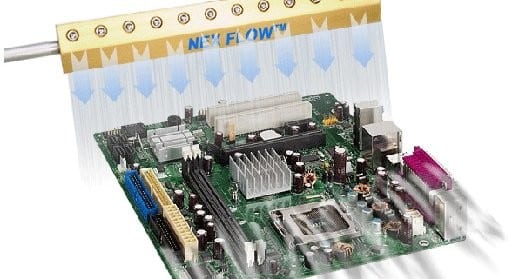
Nex Flow Air Products has participated in several industrial trade exhibitions, directly or through our various representatives worldwide.
Typically a great deal of traffic comes by when we demonstrate our products. For various reasons, Nex Flow compressed air-operated air knives have been popular at such exhibitions.
Air Knives are essentially long flat air nozzles. They often replace pipe lengths with holes or rows of individual air nozzles. Nex Flow manufactures two versions of air knives: the Standard Air Blade air knife and the X-Stream Air Blade air knife.
The standard version is an older design where the compressed air exists in the slot along the length of the air knife and bends 90 degrees around a unique aerodynamic designed surface, entraining surrounding air from the atmosphere.
Combined with entrained atmospheric air, this compressed air converts energy previously lost as pressure drop and noise into high-velocity and powerful airflow. This design is still used extensively for specific applications where the 90-degree bend is helpful.
One example is when an air barrier, such as protecting a camera lens in a dirty environment, can be utilized. The air knife may be placed in such a way that the surface of the air knife where the compressed air and entrained air occurs is made flush with the camera lens, creating a laminar airflow barrier.
The more modern air knife designs have compressed air exiting the air knife slot straight, without a bend in the flow. Again, the surfaces before the air exit must be aerodynamically designed to entrain an optimal amount of atmospheric air with the exiting compressed air.
In the Nex Flow X-Stream Air Blade air knife design, the combination of compressed and entrained air is highly efficient and produces a sharp and targeted flow pattern with a high force-to-compressed air consumption ratio.
Compared to the older standard air knife designs, they are 15% more efficient in this force-per-air consumption ratio. As a result, most applications tend to prefer these modern designs. While both air knife designs reduce noise levels, the contemporary design is significantly even better, adding to its popularity.
A considerable advantage of air knives, besides reduced noise and increased energy efficiency, is that the airflow produced is laminar flow over a significant distance. One problem with a pipe with holes is that the air exiting the holes becomes turbulent quickly. This diminishes the effective force available for blow-off or cooling very quickly, so it is only helpful if the pipe is close to the surface being addressed.
This also creates higher noise levels and uses much more energy. Rows of engineered nozzles can be effective but less efficient overall than an air knife. Because air nozzles have a specific flow pattern, the height of any manifold must be carefully set to optimize performance.
The pattern of each nozzle must touch to address the entire target but not overlap, as that would create turbulence and negatively affect the result. With an air knife, the flow along its length is continuous and is much more flexible for installation.
This video from an exhibition in Turkey demonstrates the Nex Flow X-Stream Air Blade air knife to show its performance and low noise level.





